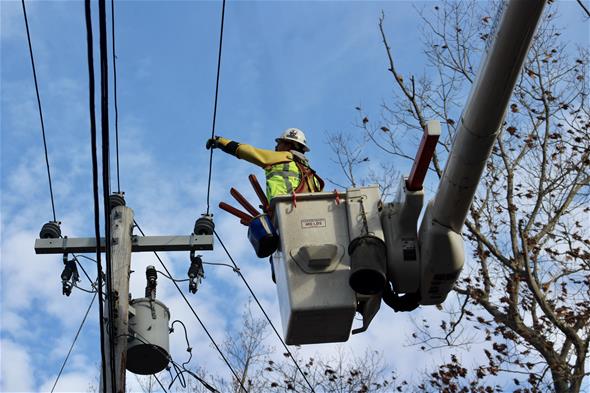Understanding Utility Poles
Learn about who manages utility poles, what a double pole is and more.
Information on this page is for customers in
{{ town-name }}

A strong distribution system is key to delivering energy reliably to the homes and businesses of customers.
After the energy travels through the transmission lines and substations, the distribution lines complete the journey to power your home, your electric vehicles and more.
Present day distribution systems also serve as conduits to supply distributed generation back to the transmission system in areas with high concentration of Distributed Energy Resources (DER).

Our grid modernization program supports investments in new technologies and planning that will increase the capacity and resiliency of our distribution system to incorporate solar generation and other clean distributed energy resources.
We are constantly improving our analytics, automation practices, technology and vegetation management on our distribution systems to enhance resiliency, maintain reliability and to restore service as quickly as possible during outages while also enabling significant interconnection of distributed generation.
Our smart-switch technology enhances reliability by allowing the remote restoration of power when a device opens due to a fault event, such as a motor vehicle accident or a tree limb that falls on wires.
In 2023 more than 40% of impacted customers—over 1.1 million—were restored within five minutes with smart switches.
The distribution automation enhancements reduce the impact on customers affected by any single outage event by more than 30% on average.
Energy storage, both on the customer side and the utility side, is a versatile tool to increase reliability and resiliency, while also encouraging the adoption of clean energy technology.
Our customer battery storage programs improve access to affordable backup energy storage during storms, while also enrolling customers in our battery storage demand response program. This program rewards customers for allowing us to draw power out of their battery at times when demand is high, thus lessening strain on the grid. In many cases, this energy is sourced from batteries storing energy produced by customers' solar panel systems.
On a larger scale, we have proposed or completed a number of energy storage projects across our states to strengthen the grid.
We have engaged more than 340 businesses and 50,000 residential customers in our demand management solutions, which help us reduce energy use during times of peak demand. This helps us save costs, reduce strain on the electric grid, and lower greenhouse gas emissions by avoiding reliance on fossil fuel generation when demand is high.
Across Connecticut, Massachusetts and New Hampshire nearly 200 megawatts were actively dispatched in the ConnectedSolutions demand response program, and we're exploring innovative ways to increase the level of customer participation, which could help us save even more in the years to come.
How much do you know about utility poles?